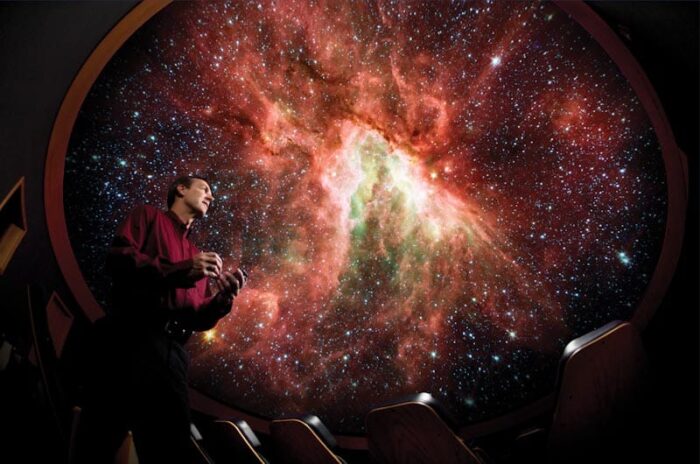Expanding Opportunities Through Research

Science Building
The 110,000 sq.-foot Science Building is a three-story facility featuring more than 35 laboratories ideal for undergraduate, graduate and faculty research in chemistry, biology and physics. The state-of-the-art planetarium brings the Commerce night sky to life on a 40-foot dome, while the Digistar 3 all-digital projection system provides the audience with sights and sounds beyond imagination.
by Sara De La Rosa
World-class research and innovation are hallmarks of a great university. For Dr. Larry Lemanski, provost and vice president for academic affairs, they are also the gold standard of academic excellence at Texas A&M University-Commerce.
After reorganizing the university into four efficient colleges and more than doubling research funding during the last few years, Lemanski believes the university is poised to increase its research efforts, with additional funding available for both graduate and undergraduate research projects.
“A&M-Commerce has recently increased its research funding from $4 million to over $7 million; we expect to reach $10 million in the near future,” Lemanski said. “This additional funding will not only result in increased research publications, it will allow the university to attract more graduate students, post-doctoral fellows and new faculty members with an interest in research.”
Paving the way for student research opportunities in every department is at the heart of Lemanski's efforts. By providing every student with the opportunity to expand their learning through research, they will graduate better prepared for success in whichever field they choose, from science and music to art and education.
“I want our students to excel and become nationally competitive, and I can see that happening now,” Lemanski said. “When I saw our music students perform at Carnegie Hall there was a certain pride in being affiliated with a university that can produce such outstanding young people.”
For Lemanski, instilling a passion for research in students begins with walking them through the research process from start to finish, then allowing them to take the lead and pursue their own projects. He currently mentors three students who are completing research for their undergraduate honors theses in addition to performing his own research.
“When I am not working with students, I do some personal research as well,” Lemanski said. “Although my time is limited, I do go over to the lab once in a while on the weekends and Friday afternoons. Most of the work, however, is done by the students.”
One of the university's most significant research-related accomplishments to date is the recent discovery of a ribonucleic acid that can promote the differentiation of non-cardiac cells, such as skin cells, into cardiac cells. While the initial discovery was made in the RNA of an axolotl salamander, student researchers have discovered a similar substance in human tissue.
“We believe this discovery could have a significant impact in the repair of diseased human cardiac tissue,” Lemanski said. “We found this RNA sequence through genetic cloning and molecular biology. This development came about much quicker than I expected. It's what makes research exciting.”
Now Lemanski is hoping to patent their findings, a process that can be much more difficult than the research process itself.
“Securing a patent requires meeting certain criteria, particularly to obtain a biomedical patent in the medical field,” Lemanski said. “Patenting a substance is not like patenting a new scalpel or technique. This is a biological substance with a unique function; it's a long process, but it's worth the effort.”
Going forward, Lemanski hopes to help every student with an interest in research find their niche, and excel in their chosen field.
“As the university grows, we want to continue to improve not only as an outstanding teaching and academic university, but also an outstanding research, scholarly and creative university,” Lemanski said. “Research developments like finding a way to repair diseased heart tissue, and those discovered by our students every day in the lab, will help bring that goal to life.”



